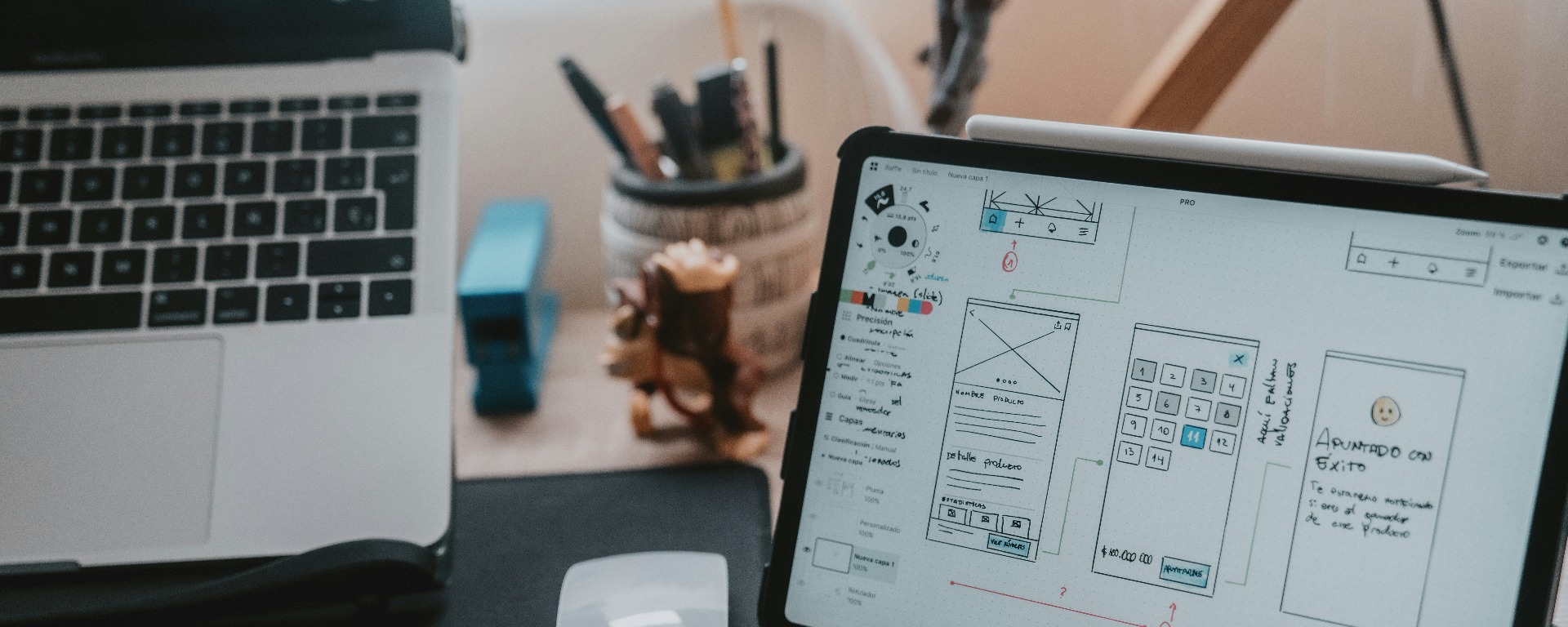What is UX and UI design?
When it comes to websites, UX design and UI design are two integral principles that must be carefully considered to maximise the impact of a website. Often used incorrectly and interchangeably, they describe very different areas. UX design centres on crafting a user experience that is both seamless and meaningful through a comprehensive understanding of user needs, research, and the creation of intuitive interfaces. In comparison, UI design emphasises the visual and interactive elements of a website, aiming to construct aesthetically pleasing interfaces.
Unlocking the power of intuitive website design
40% of individuals state that they would look for another website if the original site accessed was not mobile-friendly, while 57% of internet users say they won't recommend a business with a poorly designed website on mobile.
Implementing a website that has been crafted by a UX and UI design agency like us means that your business can create positive online experiences for your target audience. This allows you to build trust, engage website visitors, and increase conversions – and there’s no need to worry about missed leads or opportunities.
Get startedWhat are the benefits of UX and UI design?
Ensuring UX and UI principles are at the forefront of the design process has many benefits, including:

User satisfaction
A seamlessly designed UX and UI website simplifies interactions and plays a pivotal role in fostering a favourable user experience. When visitors perceive a site as user-friendly, they are more inclined to engage and revisit it.

First impressions
An aesthetically pleasing and user-friendly UI has the power to create a positive first impression, whereas a poorly designed website may deter users before they delve into your content and services.

Navigation and accessibility
Effective UX design ensures the effortless navigation of a website, enabling users to access information quickly and efficiently. Transparent navigation and an intuitive layout contribute to enhanced accessibility, particularly for users with disabilities.

Mobile responsiveness
With the surge in smartphone and tablet usage, website responsiveness is indispensable. Responsive design ensures that the website adjusts to diverse screen sizes and devices, delivering a consistent and optimal user experience across various platforms.

Brand identity
As a branding agency, we know how important UI design is in mirroring your brand's identity, encompassing colours, typography, and visual elements. A consistently well-designed brand presence across the website strengthens and fosters a unified online image.

Conversion rates
Our lead generation agency understands how a finely tuned UI can significantly boost conversion rates. When users can easily comprehend how to perform actions, such as making a purchase or completing a form, they are more inclined to follow through.

User retention
A favourable user experience not only encourages repeat visits but also cultivates loyalty. Users who enjoy interacting with your website are more likely to become devoted customers and vocal advocates for your brand.
Start thinking about your website’s UX and UI design
Not sure where to start? Whether you’re looking for a complete overhaul or need some recommendations on optimising your current website or application with UX and UI design in mind, our website design agency can help.
After developing our understanding of your target audience, needs, and goals, our talented website designers can provide recommendations for changes that will make all the difference to your website or application users.
Receive your recommendationsEssential considerations for UX and UI design
By carefully considering these aspects of UX and UI design, you can create a user-centred and visually appealing website or application that meets both user needs and business goals. Regular testing, feedback, and iteration are crucial to refining and enhancing the design throughout the development process.
User research
It’s crucial to ensure a comprehensive understanding of your target audience. User personas, crafted through thorough research, should encapsulate the diverse characteristics and preferences of your users.
By grounding your design decisions in the knowledge gained from user personas and research, you can ensure that your website or application is not only visually appealing but also aligns seamlessly with the genuine requirements of your users.
User flows
Creating a seamless and user-centric experience begins with mapping out the user journey to establish a logical and intuitive flow. By visualising the steps a user takes from entry to completion, you can identify touchpoints, interactions, and potential pain points.
Information architecture
By prioritising content based on user needs and tasks, you can ensure that essential information takes precedence, leading to a more intuitive navigation experience. This hierarchical organisation not only aids in efficient information retrieval but also contributes to a user-friendly interface, where users can quickly and seamlessly access the content most relevant to their objectives.
Usability and accessibility
This involves employing intuitive design elements, straightforward navigation pathways, and user-friendly features. This includes adherence to established accessibility standards and guidelines, which provide a framework for creating interfaces that are usable by individuals with varying abilities.
By consistently prioritising usability and refining the interface based on real user feedback, a more accessible and efficient user experience can be achieved, contributing to the overall success of the design.
Consistency
This involves maintaining uniformity across design elements, terminology, and interactions throughout the interface. By adhering to a consistent visual language and using standardised terminology, users can predict how the system operates, fostering a sense of familiarity and ease of use.
Brand consistency is also important for creating a cohesive and memorable experience. This involves maintaining uniformity in colours, typography, and imagery throughout the interface. By adhering to a consistent visual language, designers can reinforce the brand identity, making it easily recognisable and reinforcing a sense of trust and familiarity with users.
Feedback
Providing timely feedback for user actions such as confirming the successful completion of tasks, or providing guidance on how users can rectify problems, reinforces user confidence and encourages continued engagement.
This proactive approach not only aids users in understanding and overcoming obstacles but also contributes to a smoother and more intuitive interaction with the interface.
Performance
Efficient loading times contribute to quicker interactions, minimising user frustration and enhancing overall satisfaction. Additionally, it is crucial to prioritise the reduction of cognitive load on users by presenting information in an efficient and easily digestible manner.
This area of UX and UI design promotes a more fluid and user-centric experience, fostering engagement and facilitating a positive interaction with your company.
Responsive design
This adaptability ensures that the interface functions optimally across a diverse range of devices, including smartphones, tablets, and desktops.
By conducting thorough testing, potential issues related to layout, functionality, and overall user experience can be identified and resolved, guaranteeing a cohesive and responsive design.
Visual hierarchy
Establishing a clear visual hierarchy is paramount to guiding users seamlessly through the interface. This involves utilising size, colour, and contrast strategically to emphasise key elements and create a natural flow.
A well-crafted visual hierarchy not only enhances the overall user experience but also contributes to the aesthetic appeal of the UI, making it visually engaging and user-friendly.
Typography
By choosing fonts that are clear and easy to read, and ensuring appropriate font sizes, designers enhance the overall accessibility of the interface. Consistency in typography throughout the design is equally important - it fosters a unified visual language and reinforces a cohesive user experience.
Colour
By carefully choosing colours, designers can evoke specific feelings and reinforce the overall brand message. Additionally, considering colour accessibility is vital to accommodate diverse user needs. This involves ensuring sufficient contrast between text and background colours for optimal legibility.
Whitespace
The strategic use of whitespace is a fundamental technique to enhance readability and focus. Employing whitespace around elements and between content helps to create a clean and organised layout, preventing visual overload and promoting a more comfortable reading experience.
This intentional use of whitespace not only contributes to improved legibility but also directs users' attention to key elements, fostering a sense of clarity and simplicity in the interface.
Scalability
Designing with scalability in mind involves creating flexible and adaptable components that can seamlessly integrate new features and updates. By anticipating future needs and considering scalability, designers ensure that the UI can evolve without compromising visual consistency or user experience.
Interactive elements
This involves designing elements that users can easily understand and interact with, minimising the need for explicit instructions. Additionally, it's essential to ensure that interactive elements respond to user input in a clear and expected manner.
A consistent and predictable response to user input contributes to the overall usability of the interface, making the interactive elements not only functional but also a seamless and enjoyable part of the user journey.
Iconography
Icons play a crucial role in conveying information quickly and intuitively. To optimise this, it's important to choose icons that are universally recognisable and align with user expectations.
By using icons that are consistent with widely accepted conventions, designers contribute to a more user-friendly interface, where visual elements convey meaning accurately and efficiently. This approach not only aids in communication but also reinforces a seamless and intuitive user experience.
Microinteractions
Incorporating subtle animations and microinteractions can elevate the user experience, adding a layer of engagement and interactivity. However, it's crucial to ensure that these interactions enhance usability without becoming distracting. The animations should be subtle enough not to overshadow the primary content or disrupt the user's focus.
Striking the right balance between engagement and functionality ensures that the interface feels responsive and enjoyable, enhancing usability without compromising the user's ability to navigate or comprehend the content effectively.
How to approach UX and UI design
Combining both UX and UI design principles will lead to a well-rounded and effective website that connects with your target audience, builds brand trust, and drives desired actions.
As a leading UX and UI design agency based in Birmingham, we are dedicated to considering all key areas of website and application design to maximise the impact of your online presence and drive your business towards its wider goals.
What we offer
Every business is different, so understanding your unique selling points, existing online presence, overall company goals, and competitors is key to your overall success.
When reviewing the UX and UI design of your website, the following process will be followed:

Defining your purpose to identify specific goals such as user engagement or conversions.

Creating user personas and performing user and competitor research to understand your target audience's demographics, preferences, and behaviours.

Developing user flows to map out the journey users will take through your application or website.

Designing wireframes to create a skeletal representation of the interface, focusing on layout and structure.

Building, testing, and refining interactive prototypes to simulate the user experience and address potential issues.

Develop a visual style that aligns with your brand identity, paying attention to colours, typography, and imagery.

Ensuring designs are responsive, adapting to various screen sizes and devices.
What to expect from Clevercherry
At Clevercherry, we take pride in being more than just website designers. We are a leading website design agency based in the vibrant city of Birmingham, dedicated to crafting seamless digital experiences through cutting-edge UX and UI design.
Our commitment to delivering results goes beyond aesthetics, focusing on creating websites that engage visitors and convert leads into customers.
If you’re ready to optimise your website with UX and UI in mind, contact our website designers on 0121 236 1060 or via hello@clevercherry.com.
Find out more about our web design services including hosting, web-based applications, website development, security and maintenance, multi-tenant architecture, and SaaS.
Interested in our other services? We have a range of digital marketing services including SEO, social media marketing, CRO, content marketing, email marketing, PPC, and PR. We also offer brand and design services including brand identity, rebranding, exhibitions and interiors, online and offline design, and animation.
Related services
Fancy finding out more? Check out our related services.







